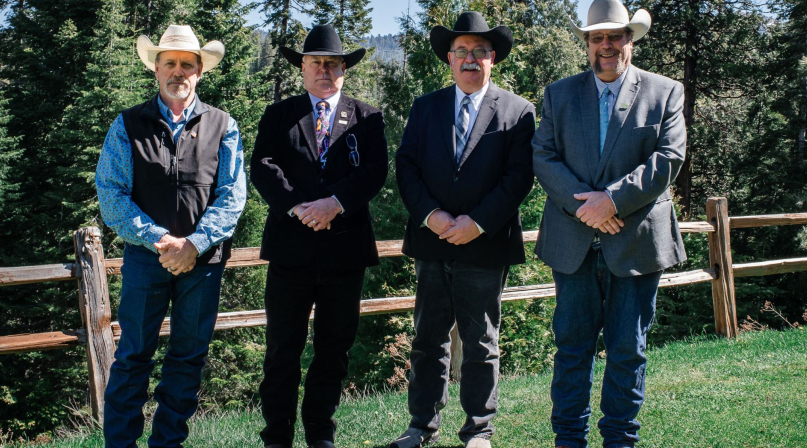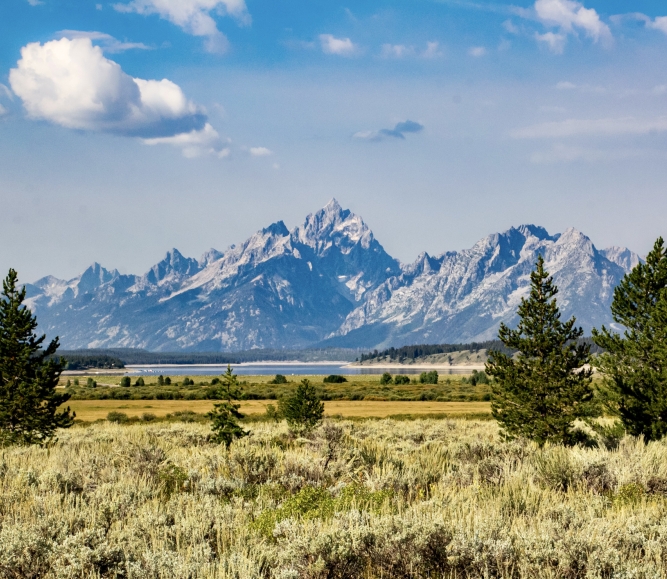Mariposa County finds third time’s a charm for WIR

Key Takeaways
After two postponements in the last four years, the Western Interstate Region Conference made its return May 7-10 in California, drawing public lands county officials to Mariposa County.
The COVID-19 pandemic forced cancellations in 2020 and 2021, but the conference came back stronger, adding Nebraska as a probationary associate member and amending WIR bylaws to allocate votes among full (five votes per state) and associate members (three votes per state). Minnesota joined WIR as an associate member in 2022.
“The more voices we can get working together, the more we can accomplish for counties and the Western region,” said Stevens County. Wash. Commissioner Wes McCart, who was elected WIR president.
Though slightly more than 1% of Nebraska is entitled to Payments in Lieu of Taxes (PILT), totaling $1.4 million in 2023, 0.2% of the national PILT authorization, Western issues are important to the state, said Jon Cannon, executive director of the Nebraska Association of County Officials.
“We just want to lend our voice to the effort. There’s a lot that we have in common with states in the West,” he said, adding that the association was investing $5 million to establish a satellite office in Keith County.
He pledged that the association would amend its bylaws to ensure that the state’s WIR Board member would represent a county from the western part of the state.
“We think it’s that important,” to have a Western presence, he said.
Mono County, Calif. Supervisor John Peters and Fremont County, Colo. Commissioner Dwayne McFall were voted as first and second vice president.
Immediate Past President John Espy, a Carbon County, Wyo. commissioner, noted an additional administrative burden borne by his state association executive director. He credited Idaho Association of Counties Executive Director Seth Grigg and Montana Association of Counties Executive Director Eric Bryson with helping throughout his presidency to alleviate the workload on Jerimiah Rieman, Wyoming County Commissioners Association executive director, who has navigated a family medical crisis during the last year.
The WIR Board voted to accept Maui County, Hawaii’s bid to play host to the 2026 conference. The 2025 conference will be held in Pennington County, S.D. May 20-24.
The state of public lands counties
The Western Interstate Region met during a tenuous moment for public lands counties, with funding for federally managed ground still up in the air, the looming publishing of the U.S. Forest Service’s rule on old growth forests and the Bureau of Land Management’s (BLM) recent rule that places conservation on equal footing with other multiple uses.
“We have an administration that has thrown out hundreds of hundreds of new rules, a lot of which will affect the West,” McCart said during the Annual Business Meeting. “We’ve got a lot of work ahead of us to protect our constituents back home.”
The PILT program remains subject to the whims of the appropriation process for the FY2025 budget and the Secure Rural Schools (SRS) program remains unauthorized, though there is an opening for it to be included in the farm bill.
“We have some time to reauthorize SRS,” NACo Chief Government Affairs Officer Mark Ritacco told the WIR Board of Directors. “There are many moving vehicles to which SRS can be attached and we want to hitch a ride with the next moving train and we really need your help to do that,” noting that direct appeals to lawmakers by county officials help support NACo advocacy efforts.
The U.S. House of Representatives recently passed a series of bills affecting public lands, including the WEST Act of 2023, which would revoke the BLM’s recently finalized conservation and landscape health rule and prevent the BLM from introducing similar rules in the future.
The NACo National Center for Public Lands Policy is continuing its fundraising effort to endow an investment fund that would finance the center’s operation, with $6 million pledged toward its $15 million goal. The center will compile land use plans, natural resource plans, legal analysis, data and more resources of value to public lands counties.
Mother of Counties
Mariposa County once encompassed 12 other California counties, stretching south to what is now Los Angeles County. More than half of what remains is federally managed, split among Yosemite National Park, the Sierra National Forest and Stanislaus National Forest.
During a joint mobile meeting of the Public Lands and Environment, Energy and Land Use committees, one attendee noted that the Sierra National Forest’s state of management assuaged some concerns about that attendee’s Forest Service land. Significant deferred infrastructure maintenance backlogs also dog the national forests. Visits to giant sequoia trees helped put the task of managing public lands in perspective for many attendees.
Yosemite National Park remains the county’s chief tourism driver, almost to a fault, making it a classic “gateway” county. Increased interest in outdoor recreation has drawn a glut of visitors that can make peak season resemble waiting in line at an amusement park. The National Park Service is developing crowd management strategies for the park, Superintendent Cicely Muldoon said during a pre-conference mobile tour.
Despite a 40-year effort for federal recognition that has thus far remained fruitless, the Southern Sierra Miwuk Tribe has maintained a strong relationship with Mariposa County.
“Essentially, the folks in D.C. have been telling us that we don’t exist, we don’t have a tribal community, we aren’t a tribe,” said Tribal Secretary Tara Fouch-Moore. “We have gotten support from the county and saying, as a government agency, we recognize these folks as a distinct Indian community, as a tribal government with political influence and community connections that are unique.
“Having their support in this process has been instrumental.”
The tribe operates the Miwumati Family Healing Center, which offers health services, mental health and counseling resources, as well as a food pantry and plays host to cultural events. But it’s open to non-native residents, too.
“Being a small rural community, we don’t have a whole lot of medical services available in our region, so again, the Indian clinic really provides a lot of services to the general community, including optometry, dental, general physician, so I think partnering with the tribal community has been beneficial to both us and the county in order to just elevate the amount of services we’re able to offer,” Fouch-Moore said.
The tribe is also collaborating with the county, the Sierra Foothill Conservancy and the Mariposa County Arts Council to restore the Mariposa Creek Parkway, the creek that runs through the town of Mariposa.
“It’s basically why the town was built there,” Fouch-Moore said. “In ancient times it was an Indian village, then it was a hot spot for the gold rush but in modern times, the town turned its back to this creek, so it’s become overrun with invasive plants.”
The county has acquired the land around the creek and the tribe has worked on the invasive plant removal, but a larger conversation has started among the partners about how the area will present itself.
“It’s been easy to harp on things like being the gateway to Yosemite and we had the gold rush, but there are many other stories that aren’t being told, including the tribal story,” she said. “The point of this is not to replace the gold rush narrative but to expand the story, tell a more rich, full story, of the history of our area that includes all people.”
The tribe’s participation in a steering committee focused on development along the parkway that has opened the door for other planning activities.
“It’s been really great that we have that trust between the counties and do all these things together,” she said.
Attendees heard from Maria Gallegos Herrera, USDA Rural Development’s state director for California; Danna Stroud, central California’s community-based solutions manager from the governor’s Office of Business and Economic Development; Brian Good, a U.S. Forest Service smokejumper who shared footage from a parachute jump into a forest fire and Adrianne Haslet, a professional ballroom dancer who spoke about her physical and mental recovery from losing part of a leg in the 2013 Boston Marathon bombing and, several years later, shattering one of her arms when she was hit by a car at the site of the bombing.
She advocated for, and won, recognition for amputee athletes in the Boston Marathon, the world’s oldest. Para Athletics Divisions offers prize money and awards to athletes with visual, lower-limb and upper-limb impairments. After Haslet’s second major injury, she trained for and finished fourth among runners with lower-limb impairments in 2022.
“Diversity is being invited to dance, inclusion is being asked to dance,” she said.
Lighter fare
Ravalli County, Mont. Commissioner Greg Chilcott was recognized as the Dale Sowards Award winner in honor of his service to public lands counties, a career in county government that started in 2003 as well as his service to the NACo Public Lands Steering Committee and a term as WIR president. Prairie County, Mont. Commissioner Todd Devlin, employed some “Rodney Dangerfield humor” to roast Chilcott.
“Greg stuck his head out the window of his pickup the other day when he went to visit with the neighbor, and he got arrested for mooning,” Devlin recalled, to applause and laughter.
Related News

U.S. House of Representatives passes SPEED Act and other permitting reform bills
On December 18, the U.S. House of Representatives passed the SPEED Act (H.R. 4776). The SPEED Act would strengthen county involvement in decision-making and make needed commonsense reforms to the federal environmental review process.

House Natural Resources Committee advances the Endangered Species Act Amendments Act of 2025
On December 17, the House Natural Resources Committee advanced the Endangered Species Act (ESA) Amendments Act of 2025 (H.R. 1897). The version passed by the committee adopted several changes from the initial bill and would address key county concerns by improving the implementation of the ESA. The legislation now awaits a floor vote before the whole U.S. House of Representatives.

County Countdown – Dec. 15, 2025
Every other week, NACo's County Countdown reviews top federal policy advocacy items with an eye towards counties and the intergovernmental partnership.
Featured Initiative
National Center for Public Lands Counties
The NACo Center for Public Lands Counties is dedicated to advancing the policy and practice study of America’s public lands counties. Our mission is to deepen the understanding and address the unique challenges faced by counties containing federal lands through strategic research and collaboration.

